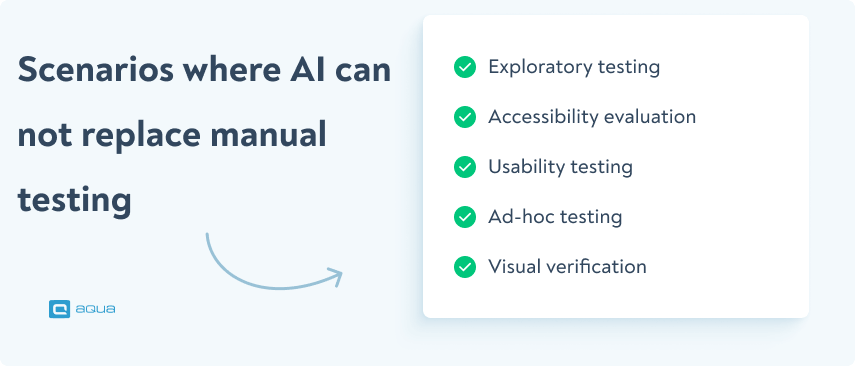Let’s cut through the noise. Manual testing isn’t dying—it’s transforming. And that transformation might just be the best thing that could happen to your testing career.
Is Automated Testing Replacing Manual Testing?
Automation has undeniably changed testing. Companies are investing heavily in test automation for reasons that make perfect business sense:
- Speed: Automated tests can run thousands of test cases in the time it takes to manually execute dozens
- Consistency: Machines don’t get bored, tired, or distracted running the same test for the 100th time
- Cost efficiency: While upfront investment is higher, the long-term ROI can be substantial
- Continuous integration: Automation fits perfectly into modern CI/CD pipelines
The numbers back this up. According to recent industry surveys:
- 44% of companies now automate more than half of their testing
- The test automation market size is expected to reach $57 billion by 2030
- Most companies report that with mature automation practices, they have 60-80% faster release cycles
This shift has naturally raised concerns among manual testers. If a script can do the job faster and with fewer mistakes, where does that leave the human tester?
Before going into detail about the importance of manual testing, you need a test management solution (TMS) for your efforts. A solution that will help you keep the balance between both approaches. Is that even possible?
Enter aqua cloud, a TMS with super-fast AI capabilities, just built for you. With aqua’s AI, you can generate test cases, requirements, and test data within just 3 clicks, in 98% less time. One-click bug-tracking integration Capture will be just as important in your journey. Automation and project management integrations like Selenium, Jenkins, Ranorex, Jira, and Azure DevOps supercharge your CI/CD practices. However, we know that you still need manual testing too, so aqua delivers an easy-to-use, 0-learning-curve centralised repository for both your automated and manual tests.
Combine all your testing efforts in one 100% AI-powered, centralised platform
Why Manual Testing Is Still Essential
Here’s where things get interesting. Despite all the advances in automation and AI, there are fundamental aspects of testing that machines simply can’t handle yet—and may never be able to.
I've been hearing about the demise of manual testing for 20 years. As others have said, it's a good idea to learn coding so you can automate things and ideally be able to take on either a manual testing roll, automated roll, or a hybrid scenario where you can do both (which I personally think would be ideal).
Manual testing brings unique qualities to the table:
Human intuition and curiosity: Humans have an innate ability to follow hunches, spot patterns, and think, “That doesn’t feel right.” We naturally ask “what if?” and explore unexpected paths through software. This intuition leads to discovering bugs that would never be found by following predetermined test cases.
Context and user perspective: A manual QA tester can put themselves in the user’s shoes, understanding frustrations, confusions, and delight in ways automation can’t measure. You know when something feels awkward or unintuitive because you experience it directly.
Adaptability on the fly: When you spot something unusual during testing, you can immediately pivot your approach. Automation follows its script exactly as written—for better or worse.
Scenarios where manual testing shines:
- Exploratory testing: Finding what you didn’t know to look for
- Usability testing: Assessing how it feels to use the software
- Ad-hoc testing: Quickly validating specific features or bug fixes
- Accessibility evaluation: Understanding real-world accessibility challenges
- Visual verification: Spotting design inconsistencies and visual bugs

Take the case of a banking app that passed all automated tests with flying colors but failed in real-world testing. Manual testers discovered that while each function worked correctly in isolation, the workflow was frustrating for users who needed to move frequently between sections. No automated test would have caught this fundamental UX issue.
Below you can experience firsthand why manual testing and automation aren’t competitors, they’re teammates in the fight against software bugs. Deploy different testing strategies against various bug types and discover which approach wins each battle, then unleash the ultimate hybrid combo for maximum effectiveness:
The Complementary Relationship Between Manual and Automated Testing
The most effective QA strategies don’t pit manual testing against automation. Instead, they recognise how these approaches complement each other. It’s not an either/or proposition—it’s a both/and strategy.
This complementary relationship works like this:
| Testing Aspect | Automation Strength | Manual Strength |
|---|---|---|
| Regression Testing | Efficiently runs hundreds of tests across builds | Identifies edge cases and unexpected impacts |
| New Features | Validates against specific requirements | Explores how features work in real-world usage |
| User Experience | Checks technical functionality | Evaluates emotional and practical usability |
| Test Coverage | Ensures broad coverage across platforms | Provides deep coverage on critical paths |
| Bug Detection | Finds consistent, predictable issues | Discovers unpredictable, context-specific bugs |
The hybrid testing approach combines the reliability and efficiency of automation with the creativity and intuition of manual testing. Companies that succeed with this balanced approach typically see:
- Faster release cycles with fewer critical bugs
- Better user satisfaction scores
- More efficient use of testing resources
- Greater test coverage across all aspects of quality
As Qualizeal points out, in the coming years, over 80% of test automation frameworks will incorporate AI-based self-healing capabilities. However, these technologies are designed to enhance manual testing rather than replace it.
Manual testing can never die because machines can only do what can be taught to them. In automation testing we can not write each and every small negative scenario until such advance technology comes which can read the requirement matrix and test the whole system without human interference and according to me we are far from that.
Skills Manual Testers Need for the Future
To thrive in this overwhelming situation, manual testers should focus on developing skills that complement rather than compete with automation. The manual QA tester of tomorrow isn’t just running test cases—they’re a strategic quality partner with unique skills that automation can’t replace.
Essential skills for the modern manual tester:
- Test design thinking: Creating thoughtful, user-centered test scenarios
- Technical awareness: Understanding automation capabilities and limitations
- Prompt engineering: Being able to train AI algorithms through sophisticated, back-and-forth prompts
- Critical analysis: Evaluating test results in context and identifying patterns
- Domain expertise: Deep knowledge of the business and user needs
- Communication skills: Clearly articulating defects and quality concerns
How to level up your manual testing career:
- Learn the basics of a test automation tool like Selenium or Cypress—not to become an automation engineer, but to understand how automation works
- Develop expertise in exploratory testing methodologies
- Get certified in specialized testing areas like security, accessibility, or performance testing
- Build your soft skills in communication, storytelling, and influence
- Understand the business domain deeply to provide more valuable testing insights
Automation is not really testing, it's automated checks to make sure regressions are detected. Manual testing is still required for confirming something meets acceptance criteria or exploratory testing (which is where most bugs are discovered). Sure automation might mean we need fewer QAs whose job is to just run regression tests, but that's about it. If you're a QA embedded in a Dev team then there is so much you can do besides automation when it comes to driving quality.
The Future of Manual Testing in an AI-Driven World
AI is changing testing—not by eliminating manual testers but by changing how they work. The future isn’t about replacement; it’s about augmentation.
Here’s how AI is already enhancing manual testing:
- Test case suggestion: AI analysing application behavior to suggest high-value test scenarios
- Bug prediction: AI identifying areas most likely to contain defects
- Visual validation: AI-powered tools helping manual testers spot visual regressions
- Test data generation: AI creating realistic test data sets for manual exploration
- Defect analysis: AI helping identify patterns in bug reports to find root causes
According to Stadsolution, “AI is becoming a helpful tool that makes manual testing better and faster,” directly challenging the notion that AI would simply take over testing jobs.
The manual tester of the future will be a skilled quality professional who:
- Uses AI tools to focus testing efforts on high-risk areas
- Leverages automation for repetitive tasks while focusing on creative testing
- Specialises in areas where human judgment remains essential
- Serves as the “quality conscience” of development teams
This evolution points to a more interesting, higher-value role for manual testers, not their extinction.
Is Manual Testing Still a Good Career Choice?
If you’re wondering whether manual testing is still a viable career path, the answer is a definite yes—with some caveats.
The key is to evolve with the industry. The days of manually executing hundreds of test cases from a test plan are indeed fading. But the need for creative, user-focused testing is stronger than ever.
Why manual testing remains a solid career choice:
- Every company needs testers who can think critically about quality
- The human element in testing cannot be automated away
- Testing skills provide a foundation for many other tech roles
- The hybrid testing approach creates new opportunities for testers with both manual and automation awareness
Research from multiple sources, including a recent LinkedIn analysis, suggests that manual testing roles are evolving rather than disappearing. Companies increasingly seek “hybrid testers” who understand both manual and automated approaches and with strong critical thinking skills.
What is Manual QA Testing Today?
The definition of manual testing has evolved. Today’s manual QA tester isn’t just someone who manually executes test cases—they’re a quality specialist who:
- Designs thoughtful test strategies based on user behavior
- Conducts exploratory testing to find unpredictable issues
- Evaluates the human experience of using software
- Serves as the user advocate throughout development
- Partners with automation efforts rather than competing with them
The modern manual QA tester might spend less time executing repetitive tests (now handled by automation) and more time on high-value activities like:
- Exploratory testing of new features
- Analyzing user feedback to identify testing opportunities
- Providing UX feedback during development
- Defining acceptance criteria that consider the user perspective
- Collaborating with automation engineers on test strategy
Conclusion
Is manual testing dying? No—it’s evolving into something potentially more valuable and interesting.
The future belongs to testers who can adapt to changing technology while leveraging the uniquely human qualities that no automation can replace: intuition, creativity, critical thinking, and user empathy. Manual testing isn’t heading for extinction; it’s heading for transformation.
For QA professionals, this evolution presents an opportunity. By developing a blend of manual testing expertise and technical awareness, you can position yourself as an essential quality partner in the development process.
Choosing aqua cloud as your partner for the combined approach will be the best decision you make. 100% traceability, test coverage, and visibility are the prerequisites you need to meet, and aqua delivers that. AI-powered requirements, test case and test data generation takes seconds, and automation integrations supercharge your testing efforts. Multi-language AI-copilot means your manual testers can work all over the world, while centralised repository combines both your automated and manual tests together effortlessly.
Achieve 100% efficiency by combining automated and manual testing


















